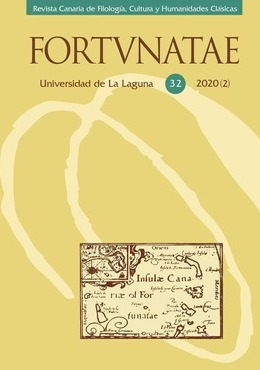Some considerations about the sources of astrology at the time of the Renaissance
Abstract
During the Renaissance period, the recovery of the main texts of ancient astrology, particularly Ptolemy, made possible a movement to reform pseudoscience that sought to eliminate all elements of medieval origin, linked to Arabic astrology. However this target was not achieved, motivated by limitations in Ptolemaic doctrines. In this paper we will analyze some of the main sources from which astrological practice was nurtured mainly during the 15th and 16th centuries, and in what way they contributed to shaping the astrological art of that time.
References
AKOPYAN, O. (2017): «Princeps aliorum and his followers: Giovanni Pico della Mirandola on the 'AstrologicalTradition’ in the Disputationes adversus astrologiam divinatricem»,Renaissance Studies 32: 4.
ATRELL, D. - PORRECA, D. (2019): Picatrix: A Medieval Treatise on Astral Magic. Magic in History, Pennsylvania State University Press, University Park (Pennsylvania).
BEN-ZAKEN, A. (2020): «Traveling with the Picatrix: cultural liminalities of science and magic», en M. FUCHS et al.(eds.), Religious Individualisation,De Gruyter, Berlin-Boston, pp. 1033-1064.
BEZZA, G. (2014): «Representation of the Skies and the Astrological Chart», en Br. DOOLEY (ed.), A Companion to Astrology in the Renaissance, Brill, Leiden-Boston, pp. 59-98.
BLUME,D.(2014):«Picturing the Stars:AstrologicalImagery in theLatinWest, 1100-1550»,en Br.DOOLEY (ed.), A Companion to Astrology in the Renaissance, Brill, Leiden-Boston, pp. 333-398.
BÒNOLI, F. - BEZZA, G. - DE MEIS, S. - COLAVITA, C. (2012): I pronostici di Domenico Maria da Novara, Leo S. Olschki, Firenze.
CAMPANELLA, T. (1629): Astrologicorum libri VI, Leyden.
CAMPION, N. (2009): A History ofWestern Astrology, vol. II. The Medieval and ModernWorlds, Continuum, London-New York.
COMPAGNI, V. P. (1977): «La magia cerimoniale del ‘Picatrix’ nel Rinascimento», Atti dell’Accademia di Scienze Morali e Politiche 88: 279-330.
DOOLEY, Br. (ed.) (2014): A Companion to Astrology in the Renaissance, Brill, Leiden-Boston.
DOOLEY, Br. (2014): «Introduction», en Br. DOOLEY (ed.), A Companion to Astrology in the Renaissance, Brill, Leiden-Boston, pp. 1-15.
EAMON,W.(2014):«Astrology andSociety»,enBr.DOOLEY (ed.),ACompaniontoAstrologyin the Renaissance, Brill, Leiden-Boston, pp. 141-191.
FARACOVI, O. (2014): «The Return to Ptolemy», en Br. DOOLEY (ed.), A Companion to Astrology in the Renaissance, Brill, Leiden-Boston, pp. 87-98.
FAUQUIER, Fr. (2000): «Le magicien-philosophe dans le Picatrix latin», en A. MOREAU - J.-C. TURPIN (eds.), La magie. Vol. 3. Du monde latin au monde contemporain, Université Paul Valéry, Séminaire d’Étude des Mentalités Antiques, Montpellier, pp. 129-146.
FERABOLI, S. (2010): Claudio Tolomeo. Le previsioni astrologiche (Tetrabiblos), Fondazione Lorenzo Valla - Arnoldo Mondadori Editore, Milano [6ª ed.].
FERRER VENTOSA, R. (2019): «La filosofía de Hermes. Investigación sobre el estudio del hermetismo como fenómeno histórico y su estado actual», Comprendre 21 (1): 5-26.
FESTUGIÈRE, A.-J. (1967): Hermétisme et mystique païenne, Aubier, Paris.
GARIN, E. (1981): El zodíaco de la vida. La polémica astrológica del Trescientos al Quinientos, Península, Barcelona.
GINGERICH,O.(1971):«Johannes Kepler and the RudolphineTables», Sky &Telescope 42 (Dec.): 328-333.
GINGERICH, O. (1973): «The role of Erasmus Reinhold and the Prutenic Tables in the dissemination of Copernican Theory», Studia Copernicana 6: 43-62.
HIRAI, H. (2014): «The New Astral Medicine», en Br. DOOLEY (ed.), A Companion to Astrology in the Renaissance, Brill, Leiden-Boston, pp. 267-286.
HOFMEIER, T. (2002): «Cudworth versus Casaubon: historical versus textual criticism», en C. GILLY - C. VAN HEEERTUM (eds.), Magic, Alchemy and Science 15th-18th centuries. The influence of HermesTrismegistus, vol. I, Centro Di Edizioni, Florencia-Venecia-Amsterdam, pp. 581-586.
HÜBNER, W. (1980): «Die Rezeption des astrologischen Lehrgedichts des Manilius in der italienischen Renaissance», en R. SCHMITZ - Fr. KRAFT (eds.), Harald Boldt, Boppard, pp. 39-67.
HÜBNER, W. (2014): «The Culture of Astrology from Ancient to Renaissance», en Br. DOOLEY (ed.), A Companion to Astrology in the Renaissance, Brill, Leiden-Boston, pp. 17-58.
KINGSLEY, P. (2000): «Poimandres: The Etymology of the Name and the Origins of the Hermetica», en R. VAN DEN BROEK - C. VAN HEERTUM (eds.), From Poimandres to Jacob Böhme: Gnosis, Hermetism and the Christian Tradition, Bibliotheca Philosophica Hermetica, In de Pelikaan, Amsterdam, pp. 41-76.
KLIBANSKY, R., PANOFSKY, E. - SAXL, Fr. (2004): Saturno y la melancolía. Estudios de historia de la filosofía de la naturaleza, la religión y el arte, Alianza Editorial, Madrid [1ª reimpr.].
LEHRICH, Ch. I. (2007): The Occult Mind: Magic inTheory and Practice, Ithaca, Cornell University Press.
PINGREE, D. (1986): Picatrix, the Latin Version of the Ghayat al-hakim, Studies of the Warburg Institute, London, 1986.
MONAT, P. (2002): Firmicus Maternus. Mathesis, Livres I-II, Les Belles Lettres, Paris.
RENAU NEBOT, X. (1999): Textos Herméticos, BCG, Gredos, Madrid.
RINALDI, M. (2002): «Sic itur ad astra». Giovanni Pontano e la sua opera astrologica nel quadro della tradizione manoscritta della «Mathesis» di Giulio Firmico Materno, Studi Latini, 45, Napoli.
VERNET, J. (2000): Astrología y astronomía en el Renacimiento, El Acantilado, Barcelona [ed. anterior, Ariel, 1974].
VESCOVINI, Gr. F. (2014): «The Theological Debate», en Br. DOOLEY (ed.), A Companion to Astrology in the Renaissance, Brill, Leiden-Boston, pp. 99-140.
YATES, FR. A. (1982): La filosofía oculta en la época isabelina, FCE, México.
YATES, FR. A. (1983): Giordano Bruno y la Tradición Hermética, Ariel, Barcelona [2º ed.].
ZAMBELLI, P. (2007): White Magic, Black Magic in the European Renaissance: From Ficino, Pico, Della Porta to Trithemius, Agrippa, Bruno, Brill, Leiden.
Authors retain copyright and grant the journal the right to be the first publication of the work as well as license it under a Creative Commons Attribution License that allows others to share the work with acknowledgment of authorship of the work and initial publication in this magazine.
Authors may separately establish additional agreements for the non-exclusive distribution of the version of the work published in the journal (for example, placing it in an institutional repository or publishing it in a book), with an acknowledgment of its initial publication in this journal.





